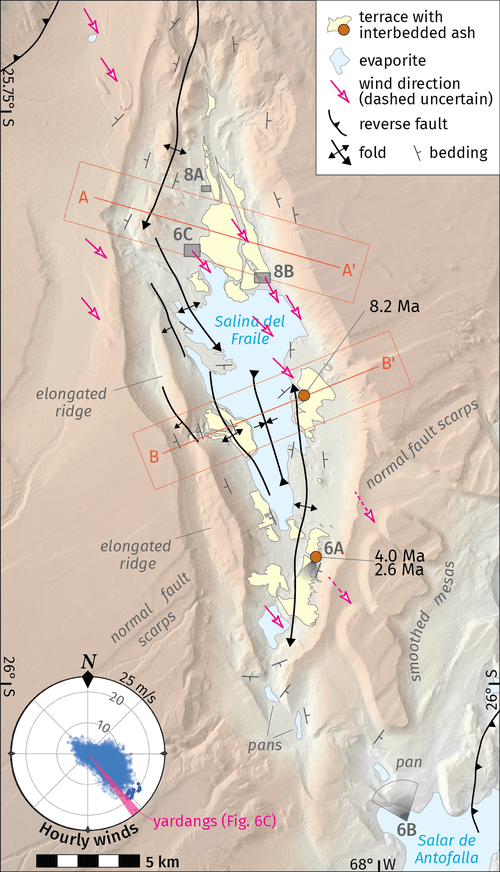Wind erosion
Hyperarid regions, such as orogenic plateaus, are mainly eroded by wind, rather than rivers or glaciers.
The Salina del Fraile depression is a large (~300 sq. km) depression about 1 km deep, with a conspicuous rhomboidal shape. In some respects, it looks like a classic pull-apart basin created by strike-slip and normal faulting (i.e., tectonic extension) but we didn’t observe any such faults in the field. Instead, the major structures are clearly compressional, not extensional, and the floor of the depression is made up of old, folded rocks. A series of anticlines (mapped as black arrows) seem to define the overall shape of the depression. This suggests that, instead of being lowered by faulting, the depression formed when rocks exhumed by the anticlines were eroded.

Map of wind-related landforms and their associated wind directions in the Salina del Fraile. Inset shows the wind directions from NASA climate reanalysis data over a 10 year period; the orientation of the strongest winds agrees very well with the wind directions inferred from various landforms. Strange landforms such as smoothed mesas and elongated ridges are also apparent.
Folds that exhume erodible strata in their cores, leading to them being hollowed out by erosion, are familiar phenomena. I mapped one such landform near Santa Fe, New Mexico as an undergrad student. There are also well-known ones in the Negev desert. The problem here? There is no evidence of rivers or glaciers in this hyperarid region, especially ones that would be powerful enough to create such a large depression.
Lindsay Schoenbohm and I developed an alternate hypothesis: that the depression was carved by wind erosion. Once we made this inference, other puzzles about the landscape began to unravel, including the appearance of conspicuously smoothed topography (large mesas and ridges) and gravel megaripples (large ripples that are made of gravel instead of sand). It seems that several million years of “normal” wind erosion (0.1 mm/yr) is enough to excavate a 1 km deep depression and to keep topographic slopes smooth, linear, and relatively free of debris. While similar landforms may be rare on Earth, we find that Mars has many smoothed topographic features, including large mesas and buttes that resemble the ones on the Puna. To read more, check out our paper published in the Journal of Geophysical Research: Earth Surface.
The interpretation of this hyperarid landscape has tectonic and geodynamic implications. The fact that we can now rule out a major episode of left-lateral transtension on a N-S trending fault (the original pull-apart basin hypothesis) means that the kinematic history of deformation is less complicated than previously thought. Instead of transtension, we see evidence for multiple phases of ~E-W compressional deformation, which are evident from folded strata and unconformities exposed in the walls of the Salina del Fraile. These were followed by a later period of ~NW-SE extension, which is evident from the pervasive normal faults and horst-and-graben structures in the SE portion of the map. As we explore in our other papers, such a sequence of deformation may be produced by a lithospheric drip.
More importantly, the observation that wind can erode through multiple kilometers of sedimnetary bedrock has implications for searching for signs of life on Mars. One challenge on Mars, especially for finding traces microbial life, is that the rocks are blasted by cosmic rays in the near surface environment. The longer the rock spends near the surface, the more degraded its complex molecules become. This means that rocks that are more rapidly brought to the surface through erosion have a better chance at preserving biosignatures.
Mars has likely been dry for the last few billion years, so the main erosional agent is wind. It is well known that wind can scour and erode huge amounts of ash-rich volcanic deposits (ignimbrites), but volcanic deposits do not likely preserve signs of microbial life. Our study now suggests that topographic features similar to the ones we map in the Salina del Fraile are signatures of wind erosion of sedimentary strata, and could be good places to look for signs of life.

Wind erosion of sedimentary bedrock on Mars. Top: track of MSL (Curiosity Rover) along the flank of Mount Sharp in Gale Crater. Landforms such as smooth mesas, which we suggest are products of wind erosion, are prominent. Bottom: View of these landforms from the rover, showing similarity to the Salina del Fraile.